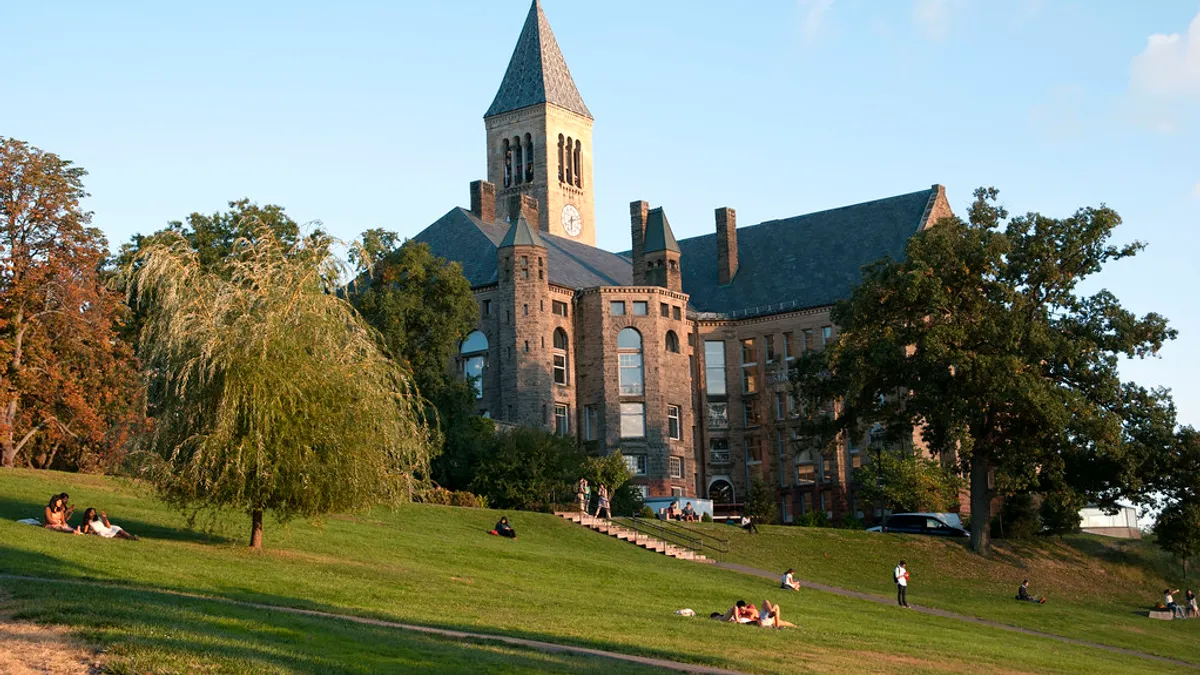Dive Brief:
- Cornell University's mass testing regime to track COVID-19 cases can be replicable in cities with strong community buy-in and effective partnerships, speakers said Monday on a US Ignite webinar.
- The university currently carries out between 6,000 and 7,000 tests a day. When students were on campus, all undergraduates were tested twice a week at seven on-campus and three off-campus sites and three. It took the on-campus laboratory up to three-and-a-half hours to process the samples and alert people of their results, said Kim Potter, operations manager for Cornell's COVID-19 Testing Laboratory, in the webinar.
- Nearly 30 full- and part-time staff with experience in infectious disease testing utilized robots to process the samples, which was crucial to accelerating testing, Potter said. She also said such mass testing on campus could not have been done without students, faculty and staff agreeing to prioritize testing over some other activities and meetings.
Dive Insight:
As U.S. cities have struggled to get community spread of the coronavirus under control, an effective testing and contact tracing regimen that can help isolate positive cases and prevent further infection has been lacking in many places. Indeed, a report last year from ABI Research found cities were "woefully unprepared" for COVID-19, while former New Orleans Mayor Mitch Landrieu said last April cities were "out of sync" on their response, meaning leaders lost time in the fight to prevent further spread, especially as they struggled with a lack of protective supplies.
And while Cornell and its host city of Ithaca, NY, have not been immune from coronavirus cases, Potter said transparency has been vital in a bid to not only show students, staff and their families that the disease is a real threat, but also to show they are taking it seriously. Potter said the quick dissemination of information about case clusters and a regularly updated dashboard tracking positive tests helped build trust with the public.
That dashboard showed 33 positive on-campus tests from Jan. 2 to Jan. 15, as well as more than 90% available capacity in its quarantine and isolation facilities. Tompkins County, NY, has a similar dashboard for its community-wide caseload and other metrics. "I just don't think we could have communicated enough," Potter said.
There were concerns about whether students would conform with the twice-a-week testing regime, or with the new rules curtailing many normal behaviors on campus. And while there were "small pockets" of misbehavior, especially in the early days of the semester, Potter said that everyone rallied together to make it work. That is a contrast from many U.S. cities, which have struggled with rising caseloads, a populace sometimes unwilling to change their behaviors to stop the spread, and testing that takes days or sometimes weeks to return a result.
"I think everyone [at Cornell] was focused on the benefits of this, and some of the other discussions that can sometimes derail things just did not misdirect us or take us off course," Potter said.
The high-speed testing involves pooling five samples together and putting them into one well on a 96-well testing plate. Once 93 of those wells are full, with the other three used for control purposes, the plate goes to a nucleic acid extractor, which purifies the ribonucleic acid (RNA) in the samples. The RNA is then taken to real-time polymerase chain reaction (PCR) detection systems for COVID-19 testing, which takes 90 minutes, before data analysis, which takes 15 minutes and determines if a pool of samples contains a positive test. If a pool comes back positive, scientists re-test just those five samples, then send an alert to the person who tested positive so they can isolate, and contact tracing can begin.
Cities throughout the United States have turned to a variety of methods to try and detect traces of COVID-19 among their residents. One of the most promising has been analyzing wastewater, a technique that has been trialed at Arizona State University among others, and accelerated by Biobot Analytics, a company out of the Massachusetts Institute of Technology that works in more than 400 U.S. cities to analyze sewer systems.
While it may be expensive for an individual city to institute its own testing regime, or have its own plan for vaccine distribution, Dr. Diego Diel, the Cornell laboratory's director, said if several work together on a regional basis, they could have success. On its own, a city may be hamstrung by a lack of resources or expertise, but those problems may lessen if jurisdictions work together, he said.
"If different communities can come together and try to come up with a solution that will help two or three different communities, I think that's probably a good way of trying to establish something like this and expand testing capacity, the availability of testing and hopefully vaccines pretty soon," Diel said during the webinar.












